Nursing Care Essay: Christopher Collins Case Study, Care Planning
VerifiedAdded on 2023/04/25
|13
|3517
|245
Report
AI Summary
This nursing care essay focuses on the comprehensive assessment, goal setting, and care planning for a patient named Christopher Collins, a 54-year-old man with a history of osteoarthritis who underwent a left high tibia knee osteotomy. The essay meticulously details the patient's background, presenting complaints, and vital signs, highlighting the signs of a surgical site infection. It then delves into the assessment data, identifying the patient's health problems, including the surgical site infection and a low platelet count. The essay outlines the identified health outcomes, such as the risk of increased bleeding and delayed wound healing. Furthermore, it discusses the nursing interventions required, emphasizing infection control measures, antibiotic prophylaxis, and effective wound care to promote healing. The essay incorporates relevant literature to support the assessment, planning, implementation, and evaluation of nursing care, providing a clear, concise, and comprehensive overview of the patient's care.

Running head: NURSING CARE ESSAY
Nursing care essay
Name of the student:
Name of the university:
Author note:
Nursing care essay
Name of the student:
Name of the university:
Author note:
Paraphrase This Document
Need a fresh take? Get an instant paraphrase of this document with our AI Paraphraser
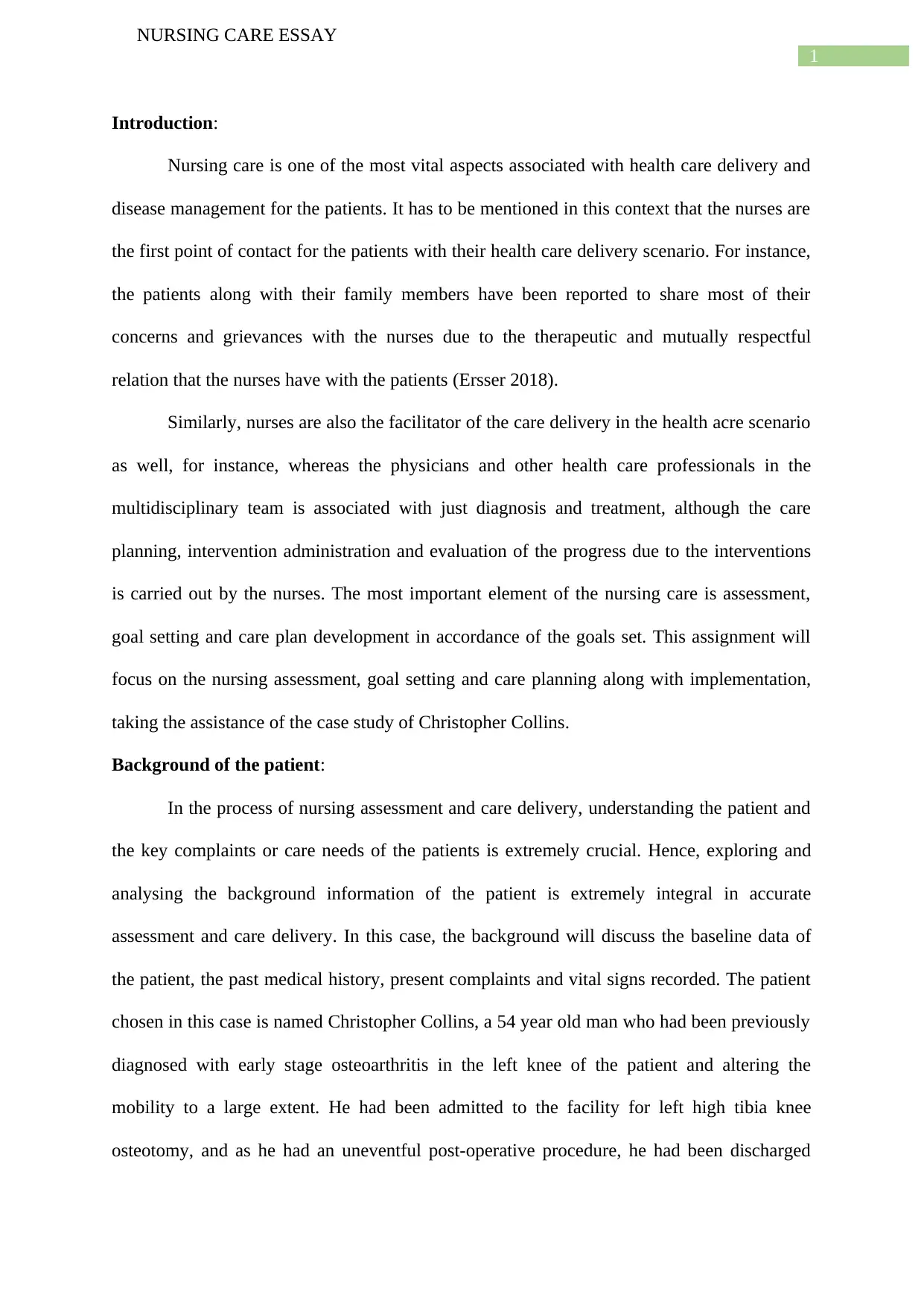
1
NURSING CARE ESSAY
Introduction:
Nursing care is one of the most vital aspects associated with health care delivery and
disease management for the patients. It has to be mentioned in this context that the nurses are
the first point of contact for the patients with their health care delivery scenario. For instance,
the patients along with their family members have been reported to share most of their
concerns and grievances with the nurses due to the therapeutic and mutually respectful
relation that the nurses have with the patients (Ersser 2018).
Similarly, nurses are also the facilitator of the care delivery in the health acre scenario
as well, for instance, whereas the physicians and other health care professionals in the
multidisciplinary team is associated with just diagnosis and treatment, although the care
planning, intervention administration and evaluation of the progress due to the interventions
is carried out by the nurses. The most important element of the nursing care is assessment,
goal setting and care plan development in accordance of the goals set. This assignment will
focus on the nursing assessment, goal setting and care planning along with implementation,
taking the assistance of the case study of Christopher Collins.
Background of the patient:
In the process of nursing assessment and care delivery, understanding the patient and
the key complaints or care needs of the patients is extremely crucial. Hence, exploring and
analysing the background information of the patient is extremely integral in accurate
assessment and care delivery. In this case, the background will discuss the baseline data of
the patient, the past medical history, present complaints and vital signs recorded. The patient
chosen in this case is named Christopher Collins, a 54 year old man who had been previously
diagnosed with early stage osteoarthritis in the left knee of the patient and altering the
mobility to a large extent. He had been admitted to the facility for left high tibia knee
osteotomy, and as he had an uneventful post-operative procedure, he had been discharged
NURSING CARE ESSAY
Introduction:
Nursing care is one of the most vital aspects associated with health care delivery and
disease management for the patients. It has to be mentioned in this context that the nurses are
the first point of contact for the patients with their health care delivery scenario. For instance,
the patients along with their family members have been reported to share most of their
concerns and grievances with the nurses due to the therapeutic and mutually respectful
relation that the nurses have with the patients (Ersser 2018).
Similarly, nurses are also the facilitator of the care delivery in the health acre scenario
as well, for instance, whereas the physicians and other health care professionals in the
multidisciplinary team is associated with just diagnosis and treatment, although the care
planning, intervention administration and evaluation of the progress due to the interventions
is carried out by the nurses. The most important element of the nursing care is assessment,
goal setting and care plan development in accordance of the goals set. This assignment will
focus on the nursing assessment, goal setting and care planning along with implementation,
taking the assistance of the case study of Christopher Collins.
Background of the patient:
In the process of nursing assessment and care delivery, understanding the patient and
the key complaints or care needs of the patients is extremely crucial. Hence, exploring and
analysing the background information of the patient is extremely integral in accurate
assessment and care delivery. In this case, the background will discuss the baseline data of
the patient, the past medical history, present complaints and vital signs recorded. The patient
chosen in this case is named Christopher Collins, a 54 year old man who had been previously
diagnosed with early stage osteoarthritis in the left knee of the patient and altering the
mobility to a large extent. He had been admitted to the facility for left high tibia knee
osteotomy, and as he had an uneventful post-operative procedure, he had been discharged
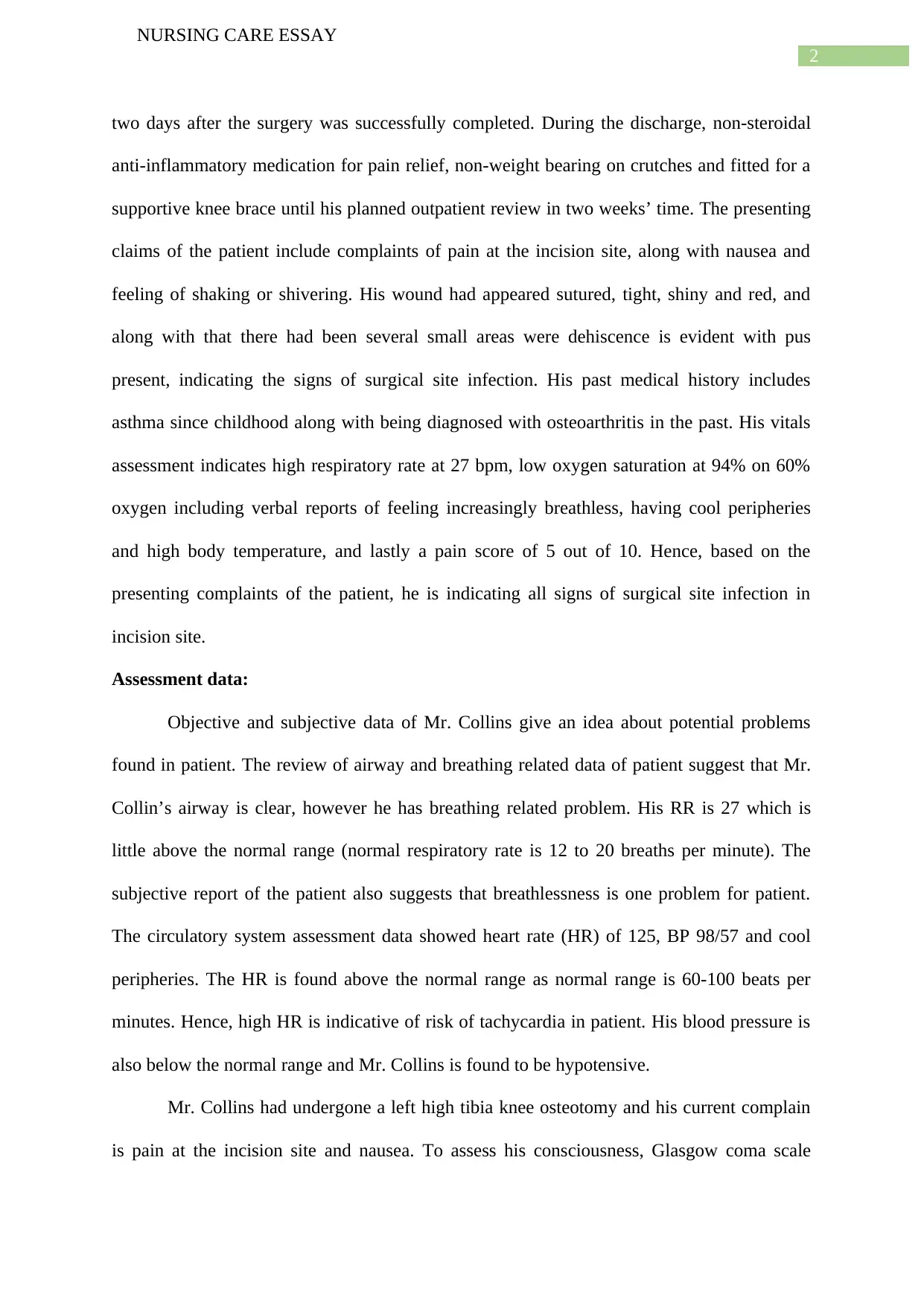
2
NURSING CARE ESSAY
two days after the surgery was successfully completed. During the discharge, non-steroidal
anti-inflammatory medication for pain relief, non-weight bearing on crutches and fitted for a
supportive knee brace until his planned outpatient review in two weeks’ time. The presenting
claims of the patient include complaints of pain at the incision site, along with nausea and
feeling of shaking or shivering. His wound had appeared sutured, tight, shiny and red, and
along with that there had been several small areas were dehiscence is evident with pus
present, indicating the signs of surgical site infection. His past medical history includes
asthma since childhood along with being diagnosed with osteoarthritis in the past. His vitals
assessment indicates high respiratory rate at 27 bpm, low oxygen saturation at 94% on 60%
oxygen including verbal reports of feeling increasingly breathless, having cool peripheries
and high body temperature, and lastly a pain score of 5 out of 10. Hence, based on the
presenting complaints of the patient, he is indicating all signs of surgical site infection in
incision site.
Assessment data:
Objective and subjective data of Mr. Collins give an idea about potential problems
found in patient. The review of airway and breathing related data of patient suggest that Mr.
Collin’s airway is clear, however he has breathing related problem. His RR is 27 which is
little above the normal range (normal respiratory rate is 12 to 20 breaths per minute). The
subjective report of the patient also suggests that breathlessness is one problem for patient.
The circulatory system assessment data showed heart rate (HR) of 125, BP 98/57 and cool
peripheries. The HR is found above the normal range as normal range is 60-100 beats per
minutes. Hence, high HR is indicative of risk of tachycardia in patient. His blood pressure is
also below the normal range and Mr. Collins is found to be hypotensive.
Mr. Collins had undergone a left high tibia knee osteotomy and his current complain
is pain at the incision site and nausea. To assess his consciousness, Glasgow coma scale
NURSING CARE ESSAY
two days after the surgery was successfully completed. During the discharge, non-steroidal
anti-inflammatory medication for pain relief, non-weight bearing on crutches and fitted for a
supportive knee brace until his planned outpatient review in two weeks’ time. The presenting
claims of the patient include complaints of pain at the incision site, along with nausea and
feeling of shaking or shivering. His wound had appeared sutured, tight, shiny and red, and
along with that there had been several small areas were dehiscence is evident with pus
present, indicating the signs of surgical site infection. His past medical history includes
asthma since childhood along with being diagnosed with osteoarthritis in the past. His vitals
assessment indicates high respiratory rate at 27 bpm, low oxygen saturation at 94% on 60%
oxygen including verbal reports of feeling increasingly breathless, having cool peripheries
and high body temperature, and lastly a pain score of 5 out of 10. Hence, based on the
presenting complaints of the patient, he is indicating all signs of surgical site infection in
incision site.
Assessment data:
Objective and subjective data of Mr. Collins give an idea about potential problems
found in patient. The review of airway and breathing related data of patient suggest that Mr.
Collin’s airway is clear, however he has breathing related problem. His RR is 27 which is
little above the normal range (normal respiratory rate is 12 to 20 breaths per minute). The
subjective report of the patient also suggests that breathlessness is one problem for patient.
The circulatory system assessment data showed heart rate (HR) of 125, BP 98/57 and cool
peripheries. The HR is found above the normal range as normal range is 60-100 beats per
minutes. Hence, high HR is indicative of risk of tachycardia in patient. His blood pressure is
also below the normal range and Mr. Collins is found to be hypotensive.
Mr. Collins had undergone a left high tibia knee osteotomy and his current complain
is pain at the incision site and nausea. To assess his consciousness, Glasgow coma scale
⊘ This is a preview!⊘
Do you want full access?
Subscribe today to unlock all pages.

Trusted by 1+ million students worldwide
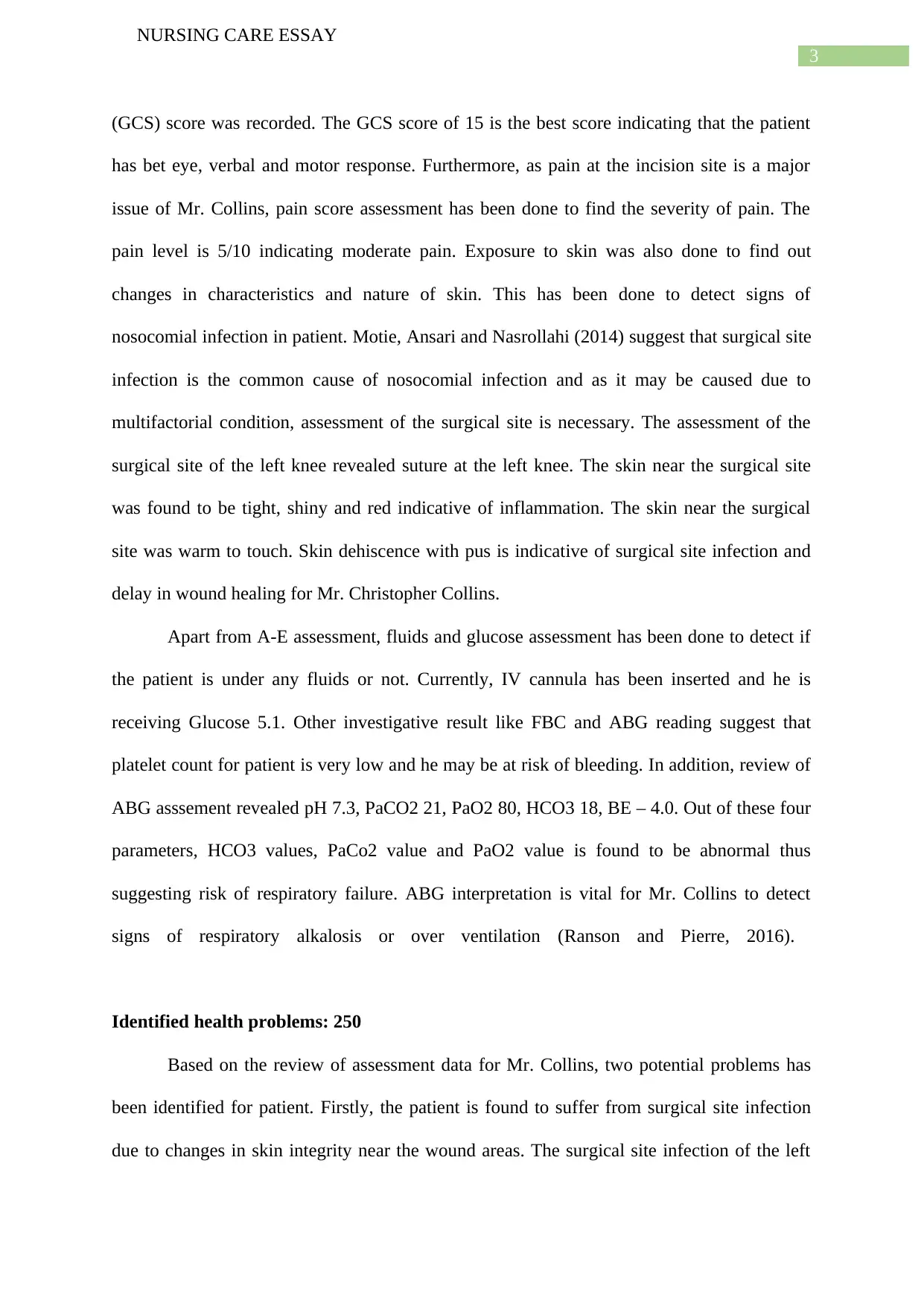
3
NURSING CARE ESSAY
(GCS) score was recorded. The GCS score of 15 is the best score indicating that the patient
has bet eye, verbal and motor response. Furthermore, as pain at the incision site is a major
issue of Mr. Collins, pain score assessment has been done to find the severity of pain. The
pain level is 5/10 indicating moderate pain. Exposure to skin was also done to find out
changes in characteristics and nature of skin. This has been done to detect signs of
nosocomial infection in patient. Motie, Ansari and Nasrollahi (2014) suggest that surgical site
infection is the common cause of nosocomial infection and as it may be caused due to
multifactorial condition, assessment of the surgical site is necessary. The assessment of the
surgical site of the left knee revealed suture at the left knee. The skin near the surgical site
was found to be tight, shiny and red indicative of inflammation. The skin near the surgical
site was warm to touch. Skin dehiscence with pus is indicative of surgical site infection and
delay in wound healing for Mr. Christopher Collins.
Apart from A-E assessment, fluids and glucose assessment has been done to detect if
the patient is under any fluids or not. Currently, IV cannula has been inserted and he is
receiving Glucose 5.1. Other investigative result like FBC and ABG reading suggest that
platelet count for patient is very low and he may be at risk of bleeding. In addition, review of
ABG asssement revealed pH 7.3, PaCO2 21, PaO2 80, HCO3 18, BE – 4.0. Out of these four
parameters, HCO3 values, PaCo2 value and PaO2 value is found to be abnormal thus
suggesting risk of respiratory failure. ABG interpretation is vital for Mr. Collins to detect
signs of respiratory alkalosis or over ventilation (Ranson and Pierre, 2016).
Identified health problems: 250
Based on the review of assessment data for Mr. Collins, two potential problems has
been identified for patient. Firstly, the patient is found to suffer from surgical site infection
due to changes in skin integrity near the wound areas. The surgical site infection of the left
NURSING CARE ESSAY
(GCS) score was recorded. The GCS score of 15 is the best score indicating that the patient
has bet eye, verbal and motor response. Furthermore, as pain at the incision site is a major
issue of Mr. Collins, pain score assessment has been done to find the severity of pain. The
pain level is 5/10 indicating moderate pain. Exposure to skin was also done to find out
changes in characteristics and nature of skin. This has been done to detect signs of
nosocomial infection in patient. Motie, Ansari and Nasrollahi (2014) suggest that surgical site
infection is the common cause of nosocomial infection and as it may be caused due to
multifactorial condition, assessment of the surgical site is necessary. The assessment of the
surgical site of the left knee revealed suture at the left knee. The skin near the surgical site
was found to be tight, shiny and red indicative of inflammation. The skin near the surgical
site was warm to touch. Skin dehiscence with pus is indicative of surgical site infection and
delay in wound healing for Mr. Christopher Collins.
Apart from A-E assessment, fluids and glucose assessment has been done to detect if
the patient is under any fluids or not. Currently, IV cannula has been inserted and he is
receiving Glucose 5.1. Other investigative result like FBC and ABG reading suggest that
platelet count for patient is very low and he may be at risk of bleeding. In addition, review of
ABG asssement revealed pH 7.3, PaCO2 21, PaO2 80, HCO3 18, BE – 4.0. Out of these four
parameters, HCO3 values, PaCo2 value and PaO2 value is found to be abnormal thus
suggesting risk of respiratory failure. ABG interpretation is vital for Mr. Collins to detect
signs of respiratory alkalosis or over ventilation (Ranson and Pierre, 2016).
Identified health problems: 250
Based on the review of assessment data for Mr. Collins, two potential problems has
been identified for patient. Firstly, the patient is found to suffer from surgical site infection
due to changes in skin integrity near the wound areas. The surgical site infection of the left
Paraphrase This Document
Need a fresh take? Get an instant paraphrase of this document with our AI Paraphraser

4
NURSING CARE ESSAY
knee reveals signs of redness, swelling and skin tightness. The surrounding areas of the
wound site has several dehiscence with pus. The presence of pus is particularly a sign of
bacterial infection in the wound because pus formation occurs when bacteria such as
Staphylococci sp. gains access to solid tissue and toxins released by the bacteria lead to acute
inflammation at the site. Initiation of inflammatory reaction at the site is associated with signs
of redness, swelling and heat (Khan, Baig and Mehboob 2017). Hence, the objective data of
redness, warm skin and swollen tissue at surgical site of the left knee for Mr. Collins is linked
to the pathophysiological changes seen in wound after the action of infectious bacteria. These
pathophysiological changes and its links with assessment data of Mr. Collins suggest that
patient has developed surgical site infection. Appropriate nursing intervention must be
immediately implemented for this problem to provided relief from pain and swelling and
promote quick recovery for the client.
Another potential health problem found for Mr. Collin is low platelet count indicating
risk of bleeding. This condition can increase risk of complications for Mr. Collins. Low
platelet count is linked to the problem of surgical site infection because the body destroys it
own platelet due to conditions which lead to too much blood clotting. Surgery and infections
are also conditions that lead to too much blood clotting and these two factors have been found
for Mr. Christopher Collin too. Zacharia et al. (2016) explains that low platelet count or
thrombocytopenia is an auto-immune disorder and in case of orthopaedic patients, post-
surgical decrease in platelet count is common. The study revealed that decrease in platelet
count occurs after surgery and it is not linked to age, gender or type of surgery. Hence, the
nursing intervention needs to focus on restoring normal platelet level to avoid risk of bleeding
and additional health issues for Mr. Client.
Identified health outcomes for problems:
In relation to the problem of surgical site infection (SSI) and impaired skin integrity
NURSING CARE ESSAY
knee reveals signs of redness, swelling and skin tightness. The surrounding areas of the
wound site has several dehiscence with pus. The presence of pus is particularly a sign of
bacterial infection in the wound because pus formation occurs when bacteria such as
Staphylococci sp. gains access to solid tissue and toxins released by the bacteria lead to acute
inflammation at the site. Initiation of inflammatory reaction at the site is associated with signs
of redness, swelling and heat (Khan, Baig and Mehboob 2017). Hence, the objective data of
redness, warm skin and swollen tissue at surgical site of the left knee for Mr. Collins is linked
to the pathophysiological changes seen in wound after the action of infectious bacteria. These
pathophysiological changes and its links with assessment data of Mr. Collins suggest that
patient has developed surgical site infection. Appropriate nursing intervention must be
immediately implemented for this problem to provided relief from pain and swelling and
promote quick recovery for the client.
Another potential health problem found for Mr. Collin is low platelet count indicating
risk of bleeding. This condition can increase risk of complications for Mr. Collins. Low
platelet count is linked to the problem of surgical site infection because the body destroys it
own platelet due to conditions which lead to too much blood clotting. Surgery and infections
are also conditions that lead to too much blood clotting and these two factors have been found
for Mr. Christopher Collin too. Zacharia et al. (2016) explains that low platelet count or
thrombocytopenia is an auto-immune disorder and in case of orthopaedic patients, post-
surgical decrease in platelet count is common. The study revealed that decrease in platelet
count occurs after surgery and it is not linked to age, gender or type of surgery. Hence, the
nursing intervention needs to focus on restoring normal platelet level to avoid risk of bleeding
and additional health issues for Mr. Client.
Identified health outcomes for problems:
In relation to the problem of surgical site infection (SSI) and impaired skin integrity
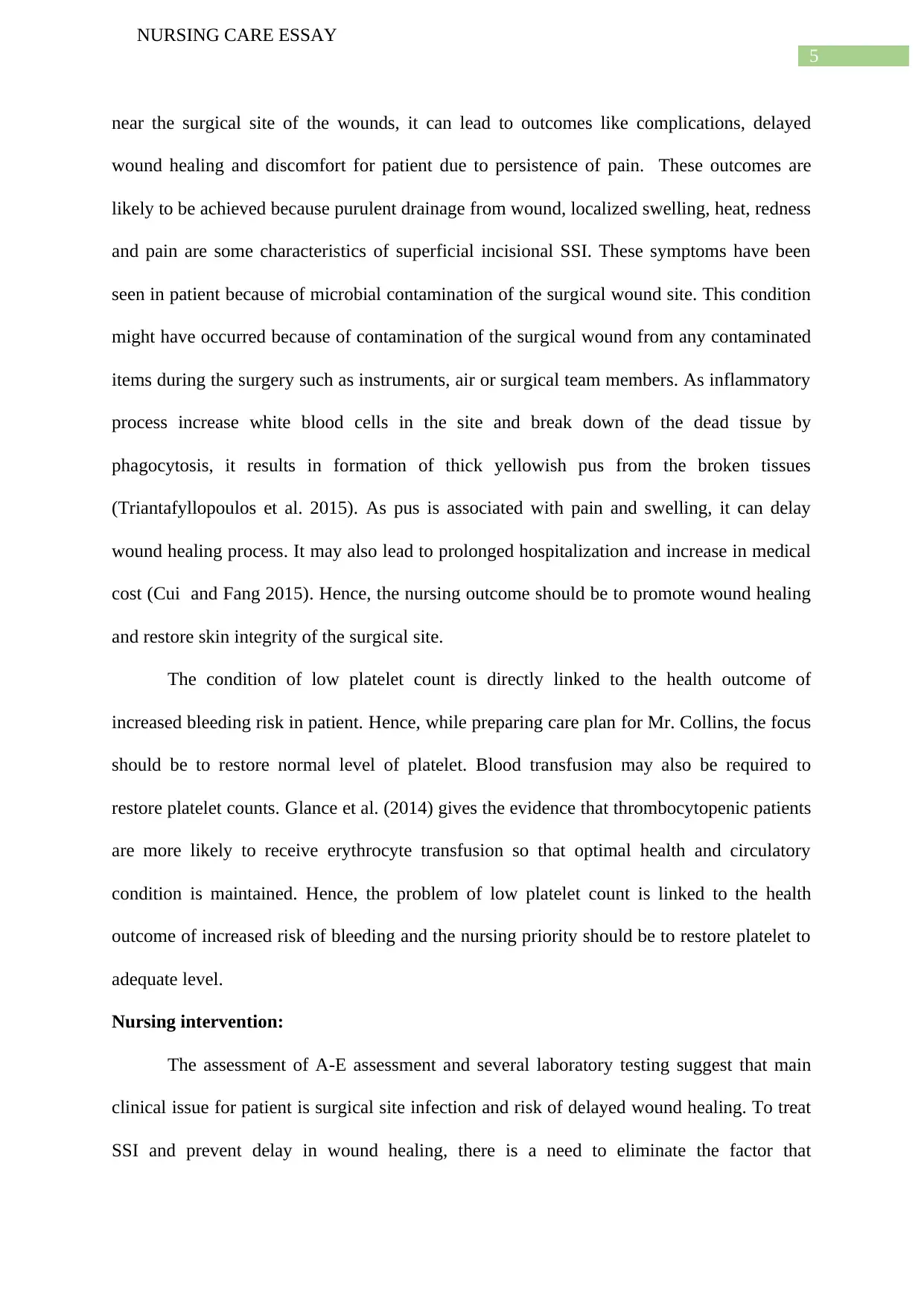
5
NURSING CARE ESSAY
near the surgical site of the wounds, it can lead to outcomes like complications, delayed
wound healing and discomfort for patient due to persistence of pain. These outcomes are
likely to be achieved because purulent drainage from wound, localized swelling, heat, redness
and pain are some characteristics of superficial incisional SSI. These symptoms have been
seen in patient because of microbial contamination of the surgical wound site. This condition
might have occurred because of contamination of the surgical wound from any contaminated
items during the surgery such as instruments, air or surgical team members. As inflammatory
process increase white blood cells in the site and break down of the dead tissue by
phagocytosis, it results in formation of thick yellowish pus from the broken tissues
(Triantafyllopoulos et al. 2015). As pus is associated with pain and swelling, it can delay
wound healing process. It may also lead to prolonged hospitalization and increase in medical
cost (Cui and Fang 2015). Hence, the nursing outcome should be to promote wound healing
and restore skin integrity of the surgical site.
The condition of low platelet count is directly linked to the health outcome of
increased bleeding risk in patient. Hence, while preparing care plan for Mr. Collins, the focus
should be to restore normal level of platelet. Blood transfusion may also be required to
restore platelet counts. Glance et al. (2014) gives the evidence that thrombocytopenic patients
are more likely to receive erythrocyte transfusion so that optimal health and circulatory
condition is maintained. Hence, the problem of low platelet count is linked to the health
outcome of increased risk of bleeding and the nursing priority should be to restore platelet to
adequate level.
Nursing intervention:
The assessment of A-E assessment and several laboratory testing suggest that main
clinical issue for patient is surgical site infection and risk of delayed wound healing. To treat
SSI and prevent delay in wound healing, there is a need to eliminate the factor that
NURSING CARE ESSAY
near the surgical site of the wounds, it can lead to outcomes like complications, delayed
wound healing and discomfort for patient due to persistence of pain. These outcomes are
likely to be achieved because purulent drainage from wound, localized swelling, heat, redness
and pain are some characteristics of superficial incisional SSI. These symptoms have been
seen in patient because of microbial contamination of the surgical wound site. This condition
might have occurred because of contamination of the surgical wound from any contaminated
items during the surgery such as instruments, air or surgical team members. As inflammatory
process increase white blood cells in the site and break down of the dead tissue by
phagocytosis, it results in formation of thick yellowish pus from the broken tissues
(Triantafyllopoulos et al. 2015). As pus is associated with pain and swelling, it can delay
wound healing process. It may also lead to prolonged hospitalization and increase in medical
cost (Cui and Fang 2015). Hence, the nursing outcome should be to promote wound healing
and restore skin integrity of the surgical site.
The condition of low platelet count is directly linked to the health outcome of
increased bleeding risk in patient. Hence, while preparing care plan for Mr. Collins, the focus
should be to restore normal level of platelet. Blood transfusion may also be required to
restore platelet counts. Glance et al. (2014) gives the evidence that thrombocytopenic patients
are more likely to receive erythrocyte transfusion so that optimal health and circulatory
condition is maintained. Hence, the problem of low platelet count is linked to the health
outcome of increased risk of bleeding and the nursing priority should be to restore platelet to
adequate level.
Nursing intervention:
The assessment of A-E assessment and several laboratory testing suggest that main
clinical issue for patient is surgical site infection and risk of delayed wound healing. To treat
SSI and prevent delay in wound healing, there is a need to eliminate the factor that
⊘ This is a preview!⊘
Do you want full access?
Subscribe today to unlock all pages.

Trusted by 1+ million students worldwide
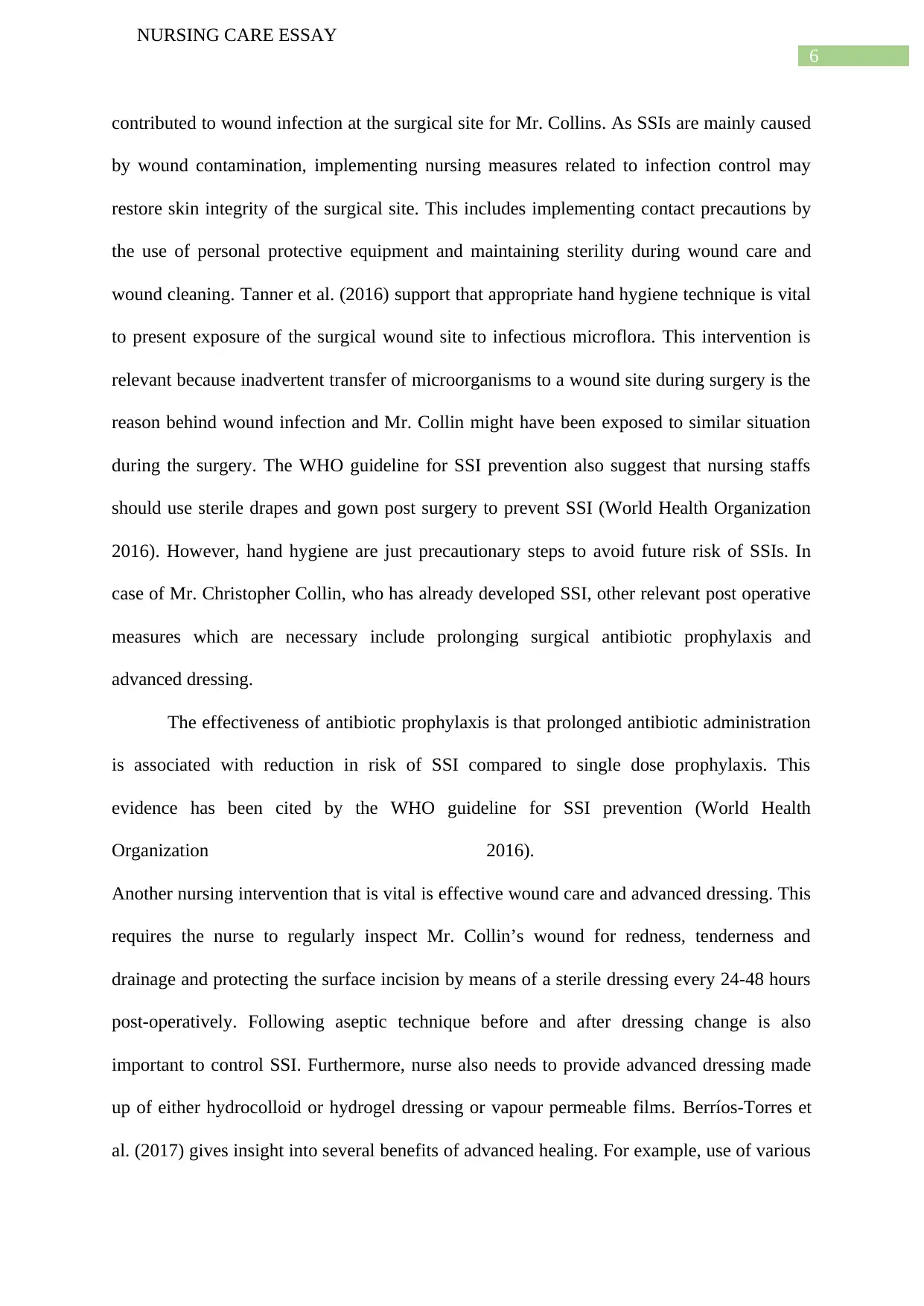
6
NURSING CARE ESSAY
contributed to wound infection at the surgical site for Mr. Collins. As SSIs are mainly caused
by wound contamination, implementing nursing measures related to infection control may
restore skin integrity of the surgical site. This includes implementing contact precautions by
the use of personal protective equipment and maintaining sterility during wound care and
wound cleaning. Tanner et al. (2016) support that appropriate hand hygiene technique is vital
to present exposure of the surgical wound site to infectious microflora. This intervention is
relevant because inadvertent transfer of microorganisms to a wound site during surgery is the
reason behind wound infection and Mr. Collin might have been exposed to similar situation
during the surgery. The WHO guideline for SSI prevention also suggest that nursing staffs
should use sterile drapes and gown post surgery to prevent SSI (World Health Organization
2016). However, hand hygiene are just precautionary steps to avoid future risk of SSIs. In
case of Mr. Christopher Collin, who has already developed SSI, other relevant post operative
measures which are necessary include prolonging surgical antibiotic prophylaxis and
advanced dressing.
The effectiveness of antibiotic prophylaxis is that prolonged antibiotic administration
is associated with reduction in risk of SSI compared to single dose prophylaxis. This
evidence has been cited by the WHO guideline for SSI prevention (World Health
Organization 2016).
Another nursing intervention that is vital is effective wound care and advanced dressing. This
requires the nurse to regularly inspect Mr. Collin’s wound for redness, tenderness and
drainage and protecting the surface incision by means of a sterile dressing every 24-48 hours
post-operatively. Following aseptic technique before and after dressing change is also
important to control SSI. Furthermore, nurse also needs to provide advanced dressing made
up of either hydrocolloid or hydrogel dressing or vapour permeable films. Berríos-Torres et
al. (2017) gives insight into several benefits of advanced healing. For example, use of various
NURSING CARE ESSAY
contributed to wound infection at the surgical site for Mr. Collins. As SSIs are mainly caused
by wound contamination, implementing nursing measures related to infection control may
restore skin integrity of the surgical site. This includes implementing contact precautions by
the use of personal protective equipment and maintaining sterility during wound care and
wound cleaning. Tanner et al. (2016) support that appropriate hand hygiene technique is vital
to present exposure of the surgical wound site to infectious microflora. This intervention is
relevant because inadvertent transfer of microorganisms to a wound site during surgery is the
reason behind wound infection and Mr. Collin might have been exposed to similar situation
during the surgery. The WHO guideline for SSI prevention also suggest that nursing staffs
should use sterile drapes and gown post surgery to prevent SSI (World Health Organization
2016). However, hand hygiene are just precautionary steps to avoid future risk of SSIs. In
case of Mr. Christopher Collin, who has already developed SSI, other relevant post operative
measures which are necessary include prolonging surgical antibiotic prophylaxis and
advanced dressing.
The effectiveness of antibiotic prophylaxis is that prolonged antibiotic administration
is associated with reduction in risk of SSI compared to single dose prophylaxis. This
evidence has been cited by the WHO guideline for SSI prevention (World Health
Organization 2016).
Another nursing intervention that is vital is effective wound care and advanced dressing. This
requires the nurse to regularly inspect Mr. Collin’s wound for redness, tenderness and
drainage and protecting the surface incision by means of a sterile dressing every 24-48 hours
post-operatively. Following aseptic technique before and after dressing change is also
important to control SSI. Furthermore, nurse also needs to provide advanced dressing made
up of either hydrocolloid or hydrogel dressing or vapour permeable films. Berríos-Torres et
al. (2017) gives insight into several benefits of advanced healing. For example, use of various
Paraphrase This Document
Need a fresh take? Get an instant paraphrase of this document with our AI Paraphraser
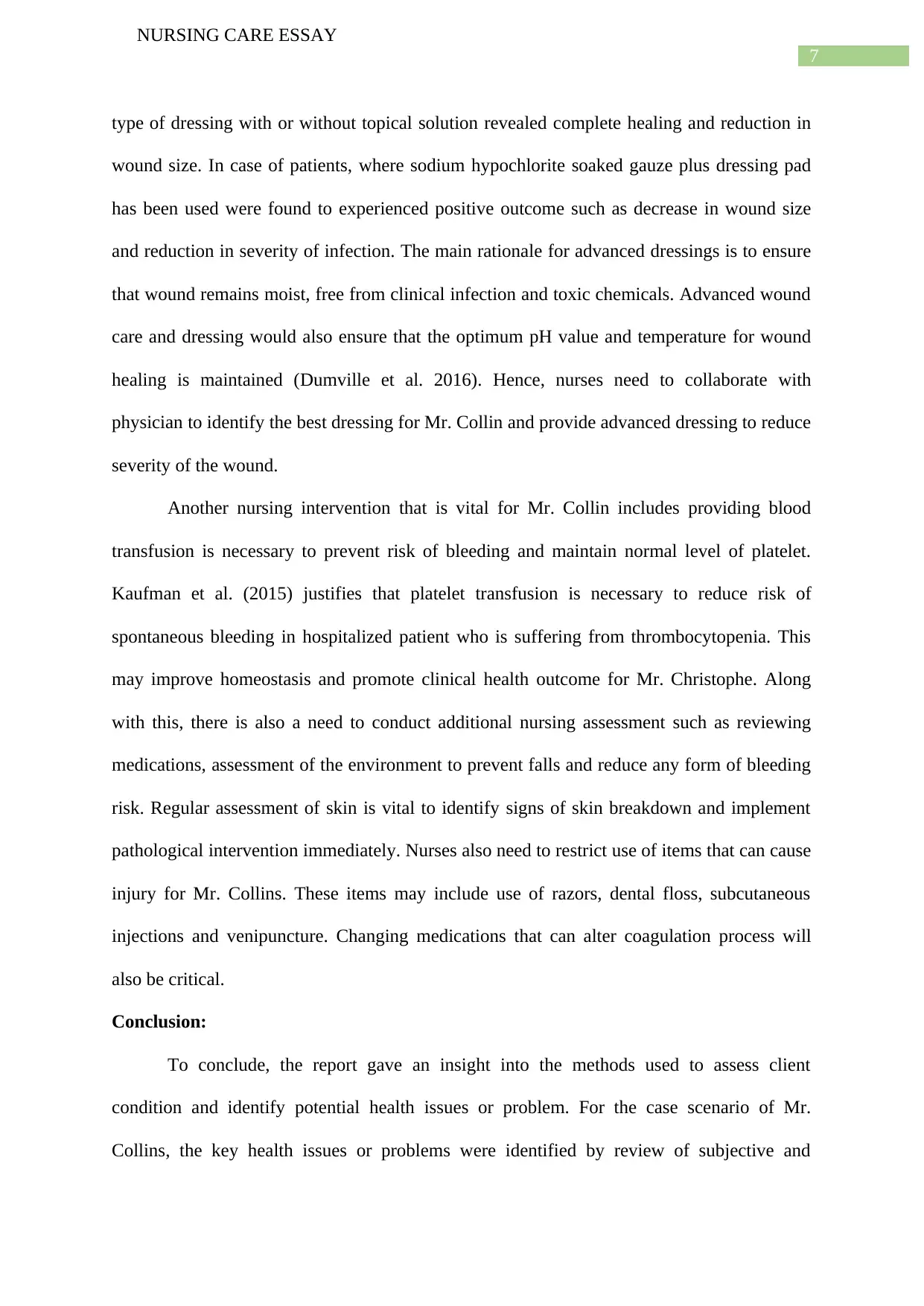
7
NURSING CARE ESSAY
type of dressing with or without topical solution revealed complete healing and reduction in
wound size. In case of patients, where sodium hypochlorite soaked gauze plus dressing pad
has been used were found to experienced positive outcome such as decrease in wound size
and reduction in severity of infection. The main rationale for advanced dressings is to ensure
that wound remains moist, free from clinical infection and toxic chemicals. Advanced wound
care and dressing would also ensure that the optimum pH value and temperature for wound
healing is maintained (Dumville et al. 2016). Hence, nurses need to collaborate with
physician to identify the best dressing for Mr. Collin and provide advanced dressing to reduce
severity of the wound.
Another nursing intervention that is vital for Mr. Collin includes providing blood
transfusion is necessary to prevent risk of bleeding and maintain normal level of platelet.
Kaufman et al. (2015) justifies that platelet transfusion is necessary to reduce risk of
spontaneous bleeding in hospitalized patient who is suffering from thrombocytopenia. This
may improve homeostasis and promote clinical health outcome for Mr. Christophe. Along
with this, there is also a need to conduct additional nursing assessment such as reviewing
medications, assessment of the environment to prevent falls and reduce any form of bleeding
risk. Regular assessment of skin is vital to identify signs of skin breakdown and implement
pathological intervention immediately. Nurses also need to restrict use of items that can cause
injury for Mr. Collins. These items may include use of razors, dental floss, subcutaneous
injections and venipuncture. Changing medications that can alter coagulation process will
also be critical.
Conclusion:
To conclude, the report gave an insight into the methods used to assess client
condition and identify potential health issues or problem. For the case scenario of Mr.
Collins, the key health issues or problems were identified by review of subjective and
NURSING CARE ESSAY
type of dressing with or without topical solution revealed complete healing and reduction in
wound size. In case of patients, where sodium hypochlorite soaked gauze plus dressing pad
has been used were found to experienced positive outcome such as decrease in wound size
and reduction in severity of infection. The main rationale for advanced dressings is to ensure
that wound remains moist, free from clinical infection and toxic chemicals. Advanced wound
care and dressing would also ensure that the optimum pH value and temperature for wound
healing is maintained (Dumville et al. 2016). Hence, nurses need to collaborate with
physician to identify the best dressing for Mr. Collin and provide advanced dressing to reduce
severity of the wound.
Another nursing intervention that is vital for Mr. Collin includes providing blood
transfusion is necessary to prevent risk of bleeding and maintain normal level of platelet.
Kaufman et al. (2015) justifies that platelet transfusion is necessary to reduce risk of
spontaneous bleeding in hospitalized patient who is suffering from thrombocytopenia. This
may improve homeostasis and promote clinical health outcome for Mr. Christophe. Along
with this, there is also a need to conduct additional nursing assessment such as reviewing
medications, assessment of the environment to prevent falls and reduce any form of bleeding
risk. Regular assessment of skin is vital to identify signs of skin breakdown and implement
pathological intervention immediately. Nurses also need to restrict use of items that can cause
injury for Mr. Collins. These items may include use of razors, dental floss, subcutaneous
injections and venipuncture. Changing medications that can alter coagulation process will
also be critical.
Conclusion:
To conclude, the report gave an insight into the methods used to assess client
condition and identify potential health issues or problem. For the case scenario of Mr.
Collins, the key health issues or problems were identified by review of subjective and
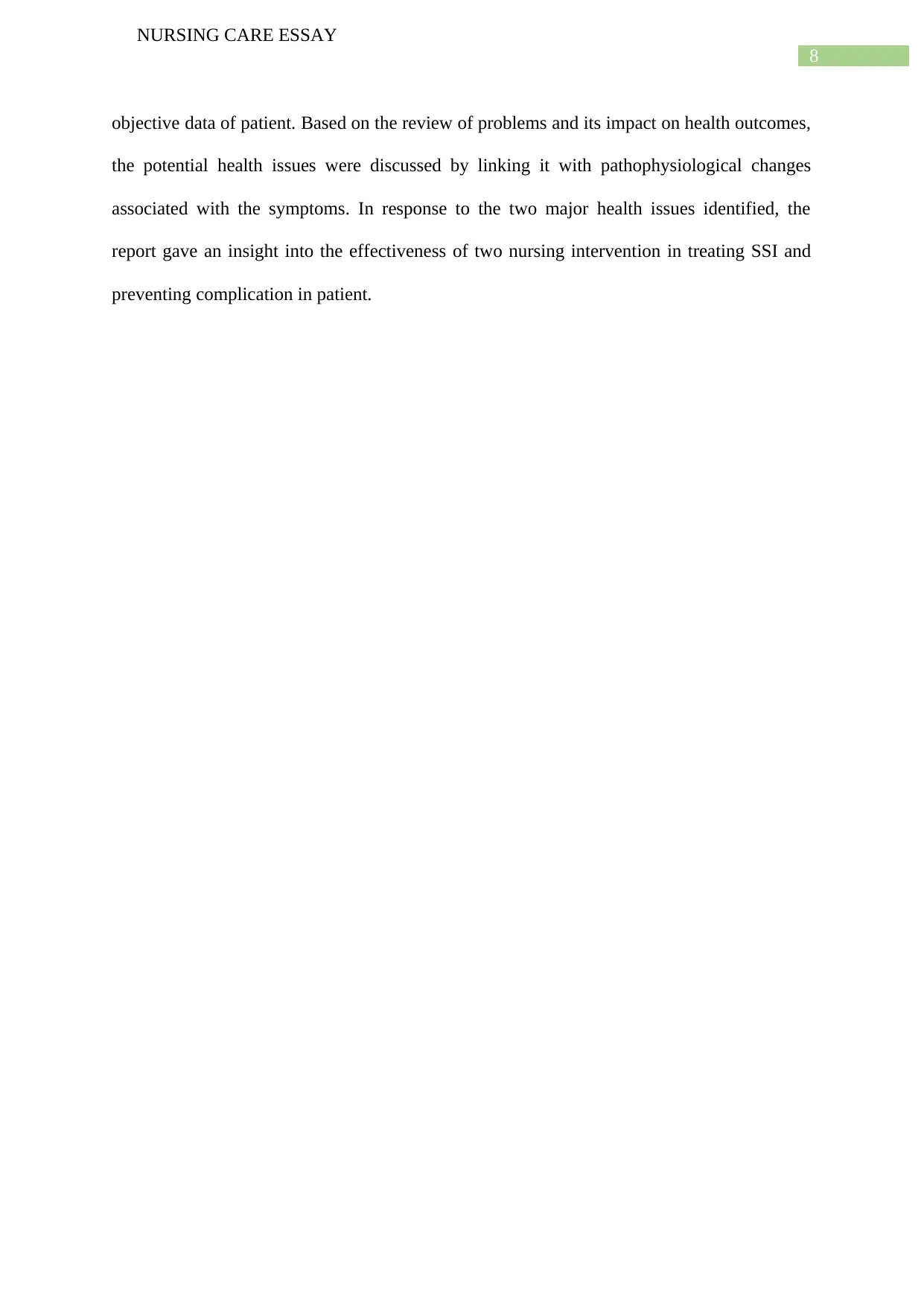
8
NURSING CARE ESSAY
objective data of patient. Based on the review of problems and its impact on health outcomes,
the potential health issues were discussed by linking it with pathophysiological changes
associated with the symptoms. In response to the two major health issues identified, the
report gave an insight into the effectiveness of two nursing intervention in treating SSI and
preventing complication in patient.
NURSING CARE ESSAY
objective data of patient. Based on the review of problems and its impact on health outcomes,
the potential health issues were discussed by linking it with pathophysiological changes
associated with the symptoms. In response to the two major health issues identified, the
report gave an insight into the effectiveness of two nursing intervention in treating SSI and
preventing complication in patient.
⊘ This is a preview!⊘
Do you want full access?
Subscribe today to unlock all pages.

Trusted by 1+ million students worldwide
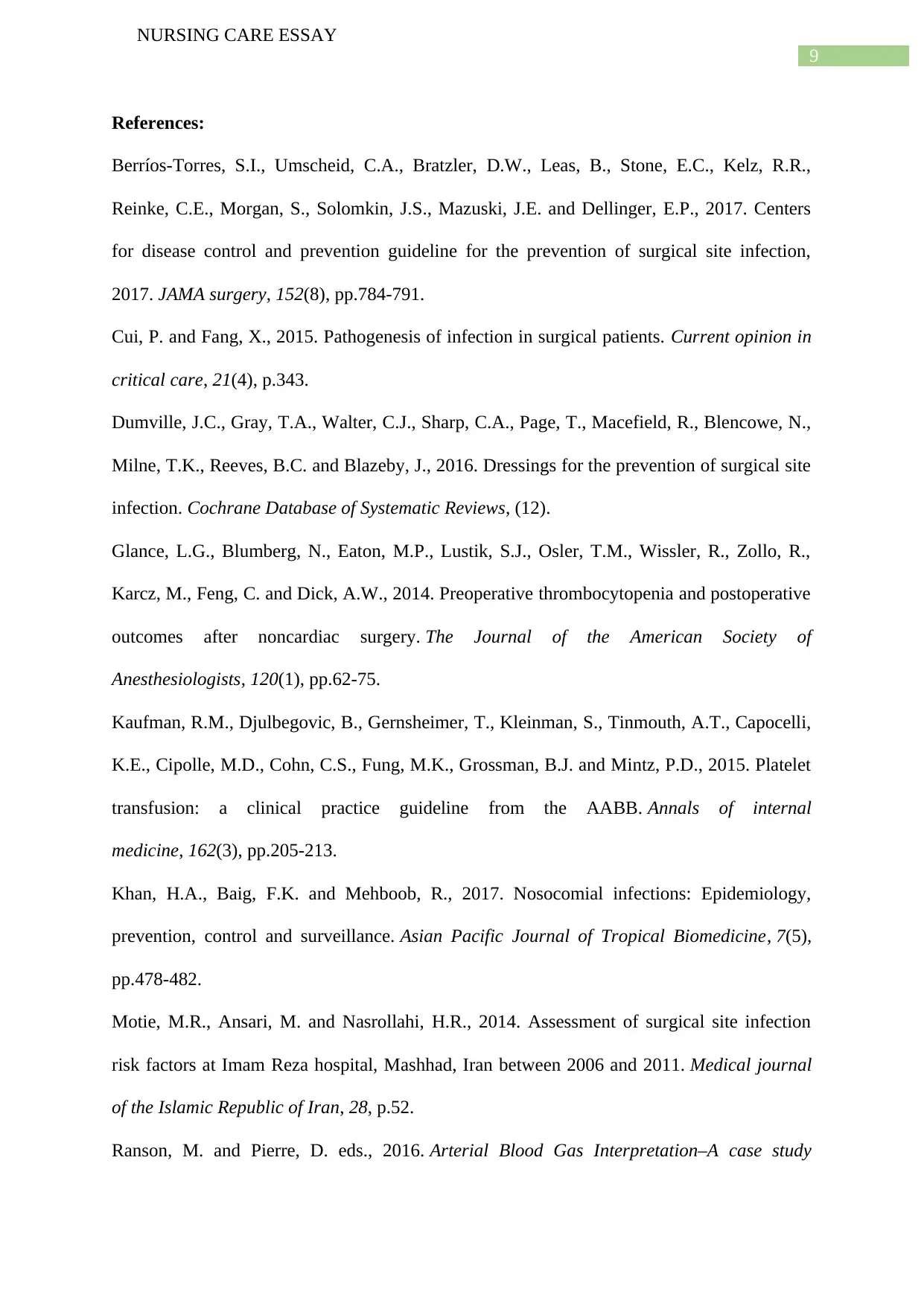
9
NURSING CARE ESSAY
References:
Berríos-Torres, S.I., Umscheid, C.A., Bratzler, D.W., Leas, B., Stone, E.C., Kelz, R.R.,
Reinke, C.E., Morgan, S., Solomkin, J.S., Mazuski, J.E. and Dellinger, E.P., 2017. Centers
for disease control and prevention guideline for the prevention of surgical site infection,
2017. JAMA surgery, 152(8), pp.784-791.
Cui, P. and Fang, X., 2015. Pathogenesis of infection in surgical patients. Current opinion in
critical care, 21(4), p.343.
Dumville, J.C., Gray, T.A., Walter, C.J., Sharp, C.A., Page, T., Macefield, R., Blencowe, N.,
Milne, T.K., Reeves, B.C. and Blazeby, J., 2016. Dressings for the prevention of surgical site
infection. Cochrane Database of Systematic Reviews, (12).
Glance, L.G., Blumberg, N., Eaton, M.P., Lustik, S.J., Osler, T.M., Wissler, R., Zollo, R.,
Karcz, M., Feng, C. and Dick, A.W., 2014. Preoperative thrombocytopenia and postoperative
outcomes after noncardiac surgery. The Journal of the American Society of
Anesthesiologists, 120(1), pp.62-75.
Kaufman, R.M., Djulbegovic, B., Gernsheimer, T., Kleinman, S., Tinmouth, A.T., Capocelli,
K.E., Cipolle, M.D., Cohn, C.S., Fung, M.K., Grossman, B.J. and Mintz, P.D., 2015. Platelet
transfusion: a clinical practice guideline from the AABB. Annals of internal
medicine, 162(3), pp.205-213.
Khan, H.A., Baig, F.K. and Mehboob, R., 2017. Nosocomial infections: Epidemiology,
prevention, control and surveillance. Asian Pacific Journal of Tropical Biomedicine, 7(5),
pp.478-482.
Motie, M.R., Ansari, M. and Nasrollahi, H.R., 2014. Assessment of surgical site infection
risk factors at Imam Reza hospital, Mashhad, Iran between 2006 and 2011. Medical journal
of the Islamic Republic of Iran, 28, p.52.
Ranson, M. and Pierre, D. eds., 2016. Arterial Blood Gas Interpretation–A case study
NURSING CARE ESSAY
References:
Berríos-Torres, S.I., Umscheid, C.A., Bratzler, D.W., Leas, B., Stone, E.C., Kelz, R.R.,
Reinke, C.E., Morgan, S., Solomkin, J.S., Mazuski, J.E. and Dellinger, E.P., 2017. Centers
for disease control and prevention guideline for the prevention of surgical site infection,
2017. JAMA surgery, 152(8), pp.784-791.
Cui, P. and Fang, X., 2015. Pathogenesis of infection in surgical patients. Current opinion in
critical care, 21(4), p.343.
Dumville, J.C., Gray, T.A., Walter, C.J., Sharp, C.A., Page, T., Macefield, R., Blencowe, N.,
Milne, T.K., Reeves, B.C. and Blazeby, J., 2016. Dressings for the prevention of surgical site
infection. Cochrane Database of Systematic Reviews, (12).
Glance, L.G., Blumberg, N., Eaton, M.P., Lustik, S.J., Osler, T.M., Wissler, R., Zollo, R.,
Karcz, M., Feng, C. and Dick, A.W., 2014. Preoperative thrombocytopenia and postoperative
outcomes after noncardiac surgery. The Journal of the American Society of
Anesthesiologists, 120(1), pp.62-75.
Kaufman, R.M., Djulbegovic, B., Gernsheimer, T., Kleinman, S., Tinmouth, A.T., Capocelli,
K.E., Cipolle, M.D., Cohn, C.S., Fung, M.K., Grossman, B.J. and Mintz, P.D., 2015. Platelet
transfusion: a clinical practice guideline from the AABB. Annals of internal
medicine, 162(3), pp.205-213.
Khan, H.A., Baig, F.K. and Mehboob, R., 2017. Nosocomial infections: Epidemiology,
prevention, control and surveillance. Asian Pacific Journal of Tropical Biomedicine, 7(5),
pp.478-482.
Motie, M.R., Ansari, M. and Nasrollahi, H.R., 2014. Assessment of surgical site infection
risk factors at Imam Reza hospital, Mashhad, Iran between 2006 and 2011. Medical journal
of the Islamic Republic of Iran, 28, p.52.
Ranson, M. and Pierre, D. eds., 2016. Arterial Blood Gas Interpretation–A case study
Paraphrase This Document
Need a fresh take? Get an instant paraphrase of this document with our AI Paraphraser
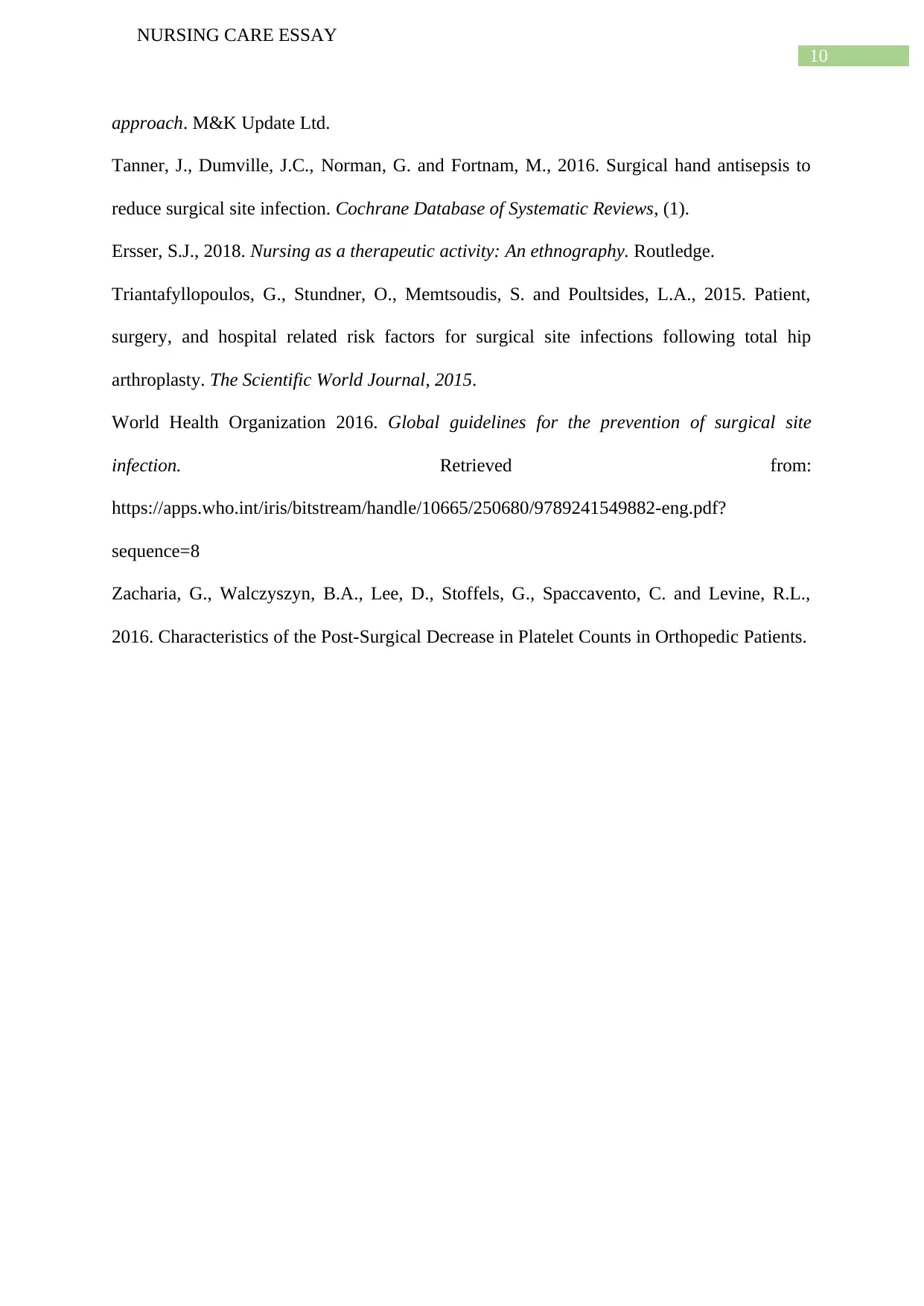
10
NURSING CARE ESSAY
approach. M&K Update Ltd.
Tanner, J., Dumville, J.C., Norman, G. and Fortnam, M., 2016. Surgical hand antisepsis to
reduce surgical site infection. Cochrane Database of Systematic Reviews, (1).
Ersser, S.J., 2018. Nursing as a therapeutic activity: An ethnography. Routledge.
Triantafyllopoulos, G., Stundner, O., Memtsoudis, S. and Poultsides, L.A., 2015. Patient,
surgery, and hospital related risk factors for surgical site infections following total hip
arthroplasty. The Scientific World Journal, 2015.
World Health Organization 2016. Global guidelines for the prevention of surgical site
infection. Retrieved from:
https://apps.who.int/iris/bitstream/handle/10665/250680/9789241549882-eng.pdf?
sequence=8
Zacharia, G., Walczyszyn, B.A., Lee, D., Stoffels, G., Spaccavento, C. and Levine, R.L.,
2016. Characteristics of the Post-Surgical Decrease in Platelet Counts in Orthopedic Patients.
NURSING CARE ESSAY
approach. M&K Update Ltd.
Tanner, J., Dumville, J.C., Norman, G. and Fortnam, M., 2016. Surgical hand antisepsis to
reduce surgical site infection. Cochrane Database of Systematic Reviews, (1).
Ersser, S.J., 2018. Nursing as a therapeutic activity: An ethnography. Routledge.
Triantafyllopoulos, G., Stundner, O., Memtsoudis, S. and Poultsides, L.A., 2015. Patient,
surgery, and hospital related risk factors for surgical site infections following total hip
arthroplasty. The Scientific World Journal, 2015.
World Health Organization 2016. Global guidelines for the prevention of surgical site
infection. Retrieved from:
https://apps.who.int/iris/bitstream/handle/10665/250680/9789241549882-eng.pdf?
sequence=8
Zacharia, G., Walczyszyn, B.A., Lee, D., Stoffels, G., Spaccavento, C. and Levine, R.L.,
2016. Characteristics of the Post-Surgical Decrease in Platelet Counts in Orthopedic Patients.
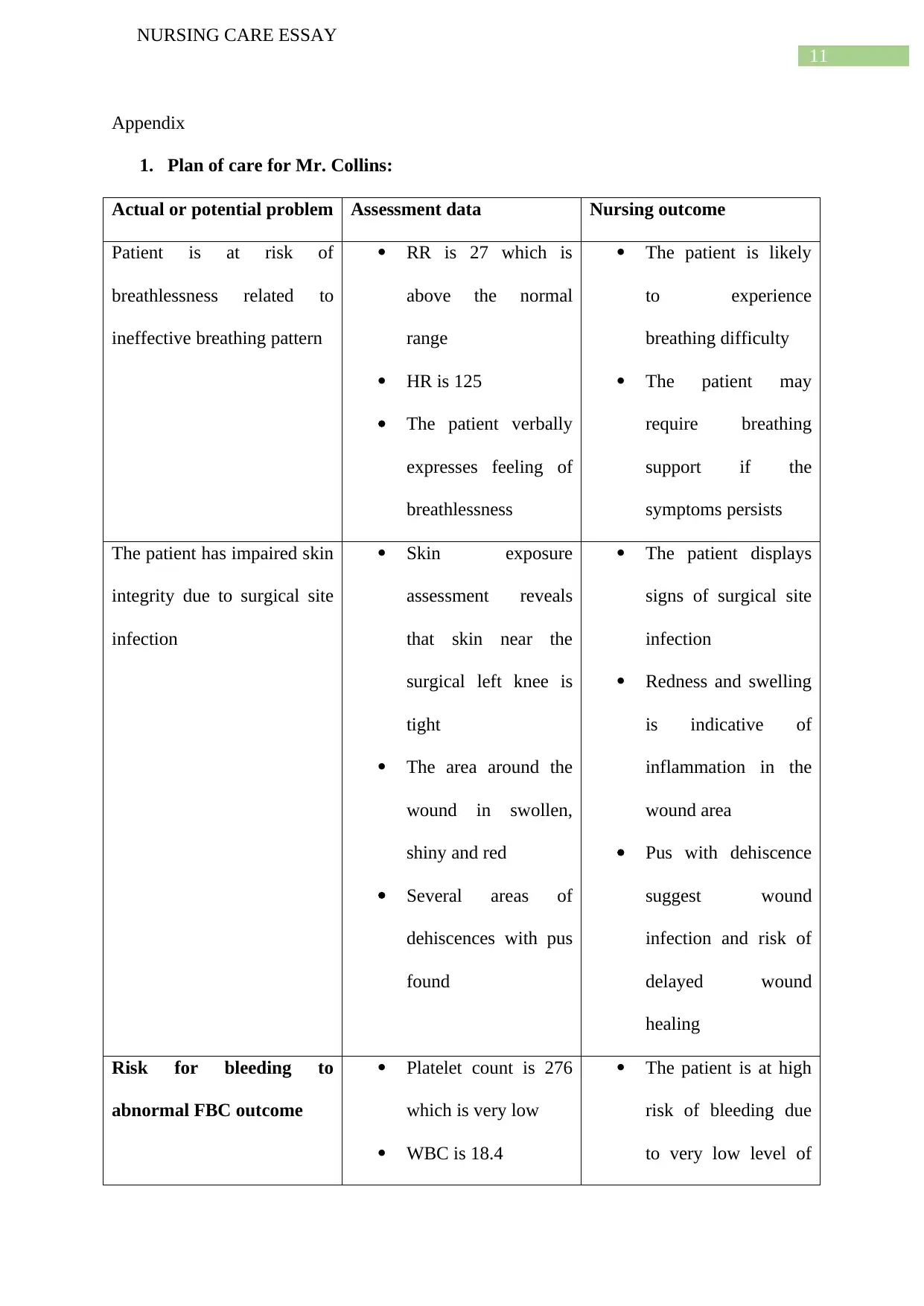
11
NURSING CARE ESSAY
Appendix
1. Plan of care for Mr. Collins:
Actual or potential problem Assessment data Nursing outcome
Patient is at risk of
breathlessness related to
ineffective breathing pattern
RR is 27 which is
above the normal
range
HR is 125
The patient verbally
expresses feeling of
breathlessness
The patient is likely
to experience
breathing difficulty
The patient may
require breathing
support if the
symptoms persists
The patient has impaired skin
integrity due to surgical site
infection
Skin exposure
assessment reveals
that skin near the
surgical left knee is
tight
The area around the
wound in swollen,
shiny and red
Several areas of
dehiscences with pus
found
The patient displays
signs of surgical site
infection
Redness and swelling
is indicative of
inflammation in the
wound area
Pus with dehiscence
suggest wound
infection and risk of
delayed wound
healing
Risk for bleeding to
abnormal FBC outcome
Platelet count is 276
which is very low
WBC is 18.4
The patient is at high
risk of bleeding due
to very low level of
NURSING CARE ESSAY
Appendix
1. Plan of care for Mr. Collins:
Actual or potential problem Assessment data Nursing outcome
Patient is at risk of
breathlessness related to
ineffective breathing pattern
RR is 27 which is
above the normal
range
HR is 125
The patient verbally
expresses feeling of
breathlessness
The patient is likely
to experience
breathing difficulty
The patient may
require breathing
support if the
symptoms persists
The patient has impaired skin
integrity due to surgical site
infection
Skin exposure
assessment reveals
that skin near the
surgical left knee is
tight
The area around the
wound in swollen,
shiny and red
Several areas of
dehiscences with pus
found
The patient displays
signs of surgical site
infection
Redness and swelling
is indicative of
inflammation in the
wound area
Pus with dehiscence
suggest wound
infection and risk of
delayed wound
healing
Risk for bleeding to
abnormal FBC outcome
Platelet count is 276
which is very low
WBC is 18.4
The patient is at high
risk of bleeding due
to very low level of
⊘ This is a preview!⊘
Do you want full access?
Subscribe today to unlock all pages.

Trusted by 1+ million students worldwide
1 out of 13
Related Documents
Your All-in-One AI-Powered Toolkit for Academic Success.
+13062052269
info@desklib.com
Available 24*7 on WhatsApp / Email
![[object Object]](/_next/static/media/star-bottom.7253800d.svg)
Unlock your academic potential
Copyright © 2020–2026 A2Z Services. All Rights Reserved. Developed and managed by ZUCOL.





